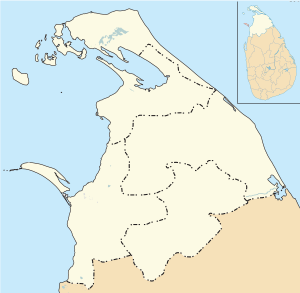| Fort Hammenhiel | |
|---|---|
| Jaffna Peninsula, Sri Lanka | |
 Fort Hammenhiel seen from Karainagar Fort Hammenhiel seen from Karainagar | |
 | |
| Coordinates | 9°42′42″N 79°50′53″E / 9.711696°N 79.848006°E / 9.711696; 79.848006 |
| Type | Defence fort |
| Site information | |
| Controlled by | Sri Lankan Navy |
| Condition | Good |
| Site history | |
| Built | 1618 |
| Built by | Portuguese and Dutch |
| Materials | Granite Stones and coral |
Fort Hammenhiel (Tamil: அம்மன்னீல் கோட்டை, romanized: Am'maṉṉīl Kōṭṭai; Sinhala: හැමන්හිල් බලකොටුව, romanized: Hæminanhil Balakotuwa) is a fort built around a small island between the islands of Kayts and Karaitivu of Jaffna Peninsula in Northern Sri Lanka.
History
The Portuguese built the fort, to guard the entrance to the Jaffna peninsula, in the mid 17th century of quarried coral naming it Fortaleza do Caes (Fort Royal). The Dutch, under the command of Captains Cornelies Reb, Piester Waset and N. van der Reede, captured the fort in March 1658 and subsequently renamed it Hammenhiel (Heel of the Ham), as they considered that shape of Ceylon resembled a smoked ham and the fort was located at the point where the shank bone projects. The Dutch rebuilt the fort in 1680, constructing a stone breakwater, filling in the hollow ramparts, replacing the upper floor with a stone vault and building a brick lined reservoir to the north of the fort. The prison has nine large dungeons to store gunpowder. The Dutch maintained a garrison of about thirty soldiers under the charge of a Lieutenant or Ensign.
The British used the fort firstly as a maximum security prison and then as an infectious diseases hospital. During the Second World War, on orders from Admiral Lord Mountbatten, Camp Hammenhiel was established in late 1944 to start a “Special Operations Group" under the command of Colonel Humphry Tollemache. Mountbatten himself visited the camp in November 1944 with Tollemache.
Notable inmates
In 1971 Rohana Wijeweera, founder leader of the Janatha Vimukthi Peramuna, was detained in the fort after his arrest. It was later used to house other prisoners of the abortive 1971 JVP insurrection. Those detained included Upatissa Gamanayake, Lionel Bopage, Podi Athula (Victor Ivan), Loku Athula (N. Jayasinghe), Prof. Jayadeva Uyangoda and Mahinda Wijesekara (who was to later to become a minister).
Later use
Having plenty of space and the proper location to detain prisoners, it was used thereafter by the Sri Lanka Navy to detain sailors accused of wrongdoings. Now it has been transformed into a tourist hotel run by the Sri Lanka Navy.
See also
References
- ^ The Times of Ceylon Annual. Times of Ceylon. 1967. pp. 27–29.
- The Ceylon Antiquary and Literary Register, Volume 5. 1920. p. 79.
- Gooneratne, Brendon (1995). The Epic Struggle of the Kingdom of Kandy and Its Relevance to Modern Indo-Sri Lankan Relations. Argus. p. 30. ISBN 9780646249575.
- ^ Ellis, Royston (3 March 2013). "Staying in Prison!". Sunday Times. Retrieved 6 December 2017.
- Silva, WK and RK. "Dutch Forts of Sri Lanka"
- Dutch East India Company (1908). Instructions from the Governor-General and Council of India to the Governor of Ceylon, 1656-1665. H.C. Cottle, Government Printer. p. 106.
- Ceylon at War 1939-45. Warwick, England: Helion & Company. 2018. p. 127. ISBN 978-1-912390-65-6.
- "Fort Hammenhiel". Amazing Lanka.
| Ancient Forts |   | |
|---|---|---|
| Colonial Forts | ||
| Less or no contribution/renovation works of Dutch are marked by † symbol under "Portuguese Forts", and others are considered as Dutch forts too. | ||
This article about a building or structure in Sri Lanka is a stub. You can help Misplaced Pages by expanding it. |
- Dutch forts in Sri Lanka
- Forts in Northern Province, Sri Lanka
- Military installations in Northern Province, Sri Lanka
- Portuguese forts in Sri Lanka
- Sri Lanka Navy
- Archaeological protected monuments in Jaffna District
- Buildings and structures associated with the Dutch East India Company
- Sri Lankan building and structure stubs